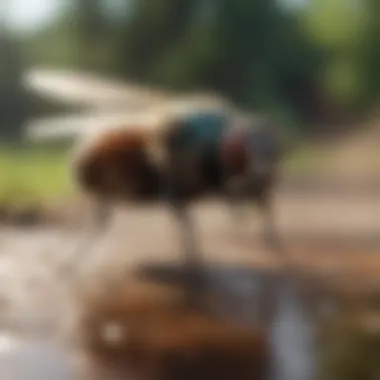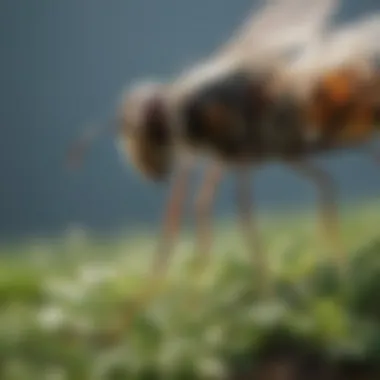Effective Household Remedies to Banish Flies Naturally


Intro
Flies are common pests found in households worldwide. They not only create an unpleasant environment but can also bring health risks by spreading diseases. Understanding effective household items to eliminate flies is essential for maintaining hygiene and comfort. This article will explore everyday substances and techniques that serve as natural and safe alternatives to chemical fly extermination products.
Animal Profile
General Overview
Flies belong to the order Diptera, which encompasses various species including house flies, fruit flies, and blowflies. The house fly, in particular, is notorious for inhabiting human dwellings. Adult flies possess a pair of wings and large compound eyes. Their rapid reproduction rate can lead to significant infestations if not managed promptly.
Habitat and Distribution
Flies thrive in diverse environments, often found in areas where food and waste are present. They are drawn to decaying organic matter, which provides them with both sustenance and ideal breeding conditions. House flies are prevalent in urban areas, while fruit flies are often spotted around ripe or fermenting fruits, indicating their varied habitats in relation to food sources.
Common Household Items for Fly Control
Utilizing ordinary items can effectively reduce fly populations. A few notable options include:
- Vinegar: Apple cider vinegar attracts flies while also serving to trap them when mixed with dish soap.
- Essential Oils: Oils such as lavender, peppermint, and eucalyptus act as natural repellents.
- Boric Acid: This compound is effective as an insecticide when used in areas frequented by flies.
Application Techniques
Practicing specific techniques can enhance the effectiveness of these household items:
- Vinegar Traps: Mix vinegar with a few drops of dish soap in a bowl. The flies get trapped in the liquid, unable to escape.
- Essential Oil Sprays: Combine water and a few drops of essential oil in a spray bottle. Spritz around entry points and areas where flies gather.
- Boric Acid Powder: Dust this powder in corners or spaces where flies are commonly found, ensuring to keep it away from pets and children.
Safety Considerations
While household items can be effective, safety is paramount. Always:
- Keep traps and poison out of reach of children and pets.
- Use essential oils in moderation, as some can be potent.
- Follow instructions for any products used to ensure proper and safe application.
End
Combating flies in the home does not require extensive measures or harmful chemicals. Simple household items, when used correctly, can significantly reduce fly presence while promoting a hygienic living environment. Educating oneself on these effective methods leads to safer and more practical approaches to pest control. By adopting these strategies, individuals can create a more pleasant domestic setting, free from the disturbance of flies.
Prelims to Fly Control
Effective fly control is essential for maintaining a clean and healthy home environment. Flies are not only a nuisance, but they also pose health risks by potentially spreading diseases. Understanding how to manage flies can help minimize these risks and improve overall hygiene in domestic settings.
Household products play a significant role in fly control. Many individuals are seeking natural alternatives to chemical-based insecticides. Household items can be efficient, cost-effective, and safer for both humans and pets. These products also reduce reliance on commercial pesticides, which can have harmful side effects on the environment.
The Role of Household Products
Household products serve as accessible solutions for managing fly populations. They contain ingredients that may exhibit insecticidal or repellent properties. For instance, vinegar is known for its ability to attract flies while simultaneously killing them when mixed appropriately. Essential oils, such as peppermint and lavender, are also gaining popularity for their pleasant scents, which can effectively deter flies.
In addition, typical kitchen staples like baking soda can serve a dual purpose—not only are they useful in cooking, they can also be employed in various fly control methods. Using these common household items contributes not only to cost savings but also to sustainable practices that align with an overall ethos of environmental care.
Common Types of Flies
There are several prevalent types of flies that can invade household spaces. Recognizing them is an important step in effective fly control. Common types include:
- House flies: These are the most familiar and can breed in decaying matter, making sanitation crucial.
- Fruit flies: Attracted to ripening or fermenting fruits, these small flies are often found around kitchens.
- Drain flies: These live in drains and sewer systems, thriving in moist environments.
- Blow flies: Typically found near carcasses or decaying meat, these are larger flies that can pose additional risks.
Each fly species has unique behaviors and preferences in terms of breeding sites and food sources. Understanding these details is crucial for implementing the most effective management strategies.


Understanding the Behavior of Flies
Understanding the behavior of flies is crucial for effective management and control. By delving into the attraction sources and the life cycle of flies, we gain insights into how to reduce their presence. Recognizing what draws flies into specific environments equips individuals with practical strategies to create less hospitable conditions for these insects.
Attraction Sources
Flies are attracted to various substances which serve as key factors in their presence. Common attraction sources include:
- Food waste: Flies are particularly drawn to decaying organic matter and food remnants. Items like overripe fruits, uncovered leftovers, and trash can be significant attractants.
- Moisture: Flies thrive in moist conditions. Stagnant water, leaky pipes, or wet surfaces can encourage breeding and feeding.
- Odors: Strong smells, whether sweet or rotten, can entice flies. This includes the scent of fermenting food, garbage, and even unclean outdoor spaces.
Improving awareness of these sources can help individuals manage their environments. Regular sanitation practices and proper storage of food can be effective deterrents and can decrease fly populations.
Life Cycle of Flies
Flies undergo a fascinating life cycle, which consists of four distinct stages: egg, larva (maggot), pupa, and adult. Understanding this life cycle is essential to implement effective control measures.
- Egg Stage: Female flies lay eggs in suitable environments, often in food waste or damp organic materials.
- Larval Stage: Once hatched, the larvae feed voraciously. This stage lasts several days, during which they grow rapidly.
- Pupal Stage: Following the larval stage, flies enter a cocoon-like structure where they undergo metamorphosis. This phase can last from a few days to weeks, depending on environmental conditions.
- Adult Stage: Finally, adult flies emerge, ready to reproduce. This stage can last a few weeks to several months, depending on food availability and environmental factors.
Understanding each stage of this life cycle allows for targeted interventions at points where control can be most effective. Knowing when and where to target cleaning and sanitation efforts is critical to reducing fly populations in any given space.
Regularly removing potential breeding sites and food sources is pivotal in preventing fly infestations. Being proactive helps maintain a hygienic environment.
Kitchen Staples as Fly Deterrents
Household kitchens are often hotspots for fly activity. Various kitchen staples have proven to be effective in repelling and even eliminating flies. Understanding how these common items can be utilized provides valuable insight for managing fly populations without resorting to chemical solutions. In addition to being cost-effective, these methods are also safe for both humans and pets.
Vinegar Solutions
Vinegar is a well-known substance in many homes, prized for its versatility in cooking and cleaning. Its acidic nature acts as a potent fly deterrent. Flies are generally deterred by the strong odor of vinegar, particularly apple cider vinegar. To create a simple fly trap, mix equal parts of vinegar and water in a bowl. A few drops of dish soap can be added to break the surface tension, allowing flies to sink rather than escape. This approach not only attracts flies but effectively traps them as well.
Essential Oils
Essential oils are celebrated for their aromatic properties and therapeutic applications. They also provide effective fly-repelling capabilities. The following oils are particularly noteworthy:
Peppermint Oil
Peppermint Oil offers a strong scent that flies find unpleasant. Its high menthol content acts as a natural repellent. Additionally, it can be combined with water in a spray bottle for easy application around windows and doors, creating an aromatic barrier against flies. One interesting aspect of Peppermint Oil is its ability to repel multiple types of insects, including ants and spiders, making it a multi-purpose solution. It can be a beneficial choice in areas that often experience fly problems.
Lavender Oil
Lavender Oil is another household favorite for fly control. Known for its calming scent, it also possesses insect-repelling properties. The floral aroma can deter flies while offering a pleasant fragrance in living spaces. Lavender can be used in sachets hung around the kitchen or diluted in water to create a spray. Its unique feature lies in its dual functionality, promoting a soothing atmosphere while combating pests. This makes Lavender Oil especially attractive for households concerned about ambiance and insect control simultaneously.
Eucalyptus Oil
Eucalyptus Oil is recognized for its refreshing scent. It is effective in repelling flies and other insects thanks to its high concentration of eucalyptol. This compound has been shown to inhibit the sensing capabilities of flies, rendering them less likely to approach treated areas. Eucalyptus Oil can be used in a diffuser or mixed with water as a spray. While it is highly effective, users should ensure sufficient ventilation, as the strength of the aroma may be overwhelming in confined spaces.
Baking Soda
Baking Soda serves various purposes in household applications. It acts as a natural insecticide when mixed with sugar or something sweet. Flies are attracted to the sugar, but ingesting baking soda causes internal gas buildup, leading to their demise. However, caution must be taken not to overuse this method, as it may affect other household insects and the balance of the ecosystem in your home. Placing small dishes of this mixture in problem areas can help reduce fly numbers effectively.
With these kitchen staples serving as deterrents, the process of managing flies becomes notably simpler. Each method utilizes common household items, making it accessible and safe for everyone. Incorporating these approaches into routine cleaning and maintenance can significantly reduce fly populations in any home setting.
Natural Insecticides from the Pantry
The use of natural insecticides from the pantry has gained attention in recent years. This approach offers a way to manage fly populations without the harmful side effects of commercial chemicals. Household items not only serve as eco-friendly alternatives but are also often safer for humans and pets. Utilizing what we already have in our kitchens allows for a practical and cost-effective solution to pest control.


Salt and Water Mixtures
Salt is a common ingredient found in nearly every household. Its insecticidal properties are not widely recognized yet it is effective at controlling flies. When mixed with water, it creates a solution that can be sprayed directly on flying insects. The mixture works by dehydrating the flies upon contact, ultimately leading to their demise. To create a simple salt and water insecticide:
- Combine two tablespoons of salt in a spray bottle filled with water.
- Shake the mixture to ensure the salt dissolves completely.
- Aim the spray toward flies, particularly in areas where they gather.
This method is straightforward. The ingredients are readily available and require minimal effort to implement. Additionally, it does not leave harmful residues, making it a preferred choice for households with children or pets.
Soap and Water Solutions
Soap is another effective and accessible household item. When combined with water, it can be used to trap and kill flies. The science behind this method revolves around the properties of soap, which breaks down the outer barrier of the insects, suffocating them. To prepare this solution, follow these steps:
- Use a liquid soap like dish soap or Castile soap.
- Mix one to two teaspoons of soap with a quart of water in a spray bottle.
- Shake the bottle gently to create a soapy solution.
- Spray it on flies, focusing on their resting places.
This approach not only targets flies but can also deter other pests. Importantly, soap solutions are non-toxic and less hazardous compared to conventional insecticides. They can be safely used in households without concerns for poisoning or chemical exposure. Care should be taken not to spray on plants, as soap can harm some vegetation.
Using natural insecticides from the pantry can minimize environmental damage while effectively controlling fly populations in your home.
By leveraging simple ingredients like salt and soap, individuals can adopt sustainable practices to manage pests. Such methods contribute to a more hygienic environment while reducing reliance on chemical solutions.
Repellent Strategies Using Household Materials
The application of household materials as fly repellents is a practical approach to managing fly populations in domestic settings. Many common substances can deter flies due to their inherent properties. Utilizing these materials not only promotes hygiene but also minimizes the reliance on industrial insecticides. This strategy emphasizes environmental consciousness and safety for all users, including pets and children.
Using Lemon and Cloves
Lemon paired with cloves is an effective method to repel flies. The citrusy scent of lemon is known to irritate flies, while the pungent aroma of cloves works as an effective agent to keep them away. This combination is easy to prepare and can infuse your home with a pleasant fragrance while serving as a natural insect deterrent.
To create this repellent, simply cut a lemon in half and insert entire cloves into the exposed flesh. Place the prepared lemons in areas where flies are often spotted, such as kitchens or dining spaces. This method not only prevents flies from entering the vicinity but also adds a decorative touch to your home.
Benefits:
- Natural odor: Offers a fresh scent while repelling flies.
- Non-toxic: Safe for use around children and pets.
- Aesthetic: The bright yellow color of lemons contrasts pleasingly with the dark cloves.
Considerations:
- Effectiveness: Regularly replace the lemons to maintain effectiveness, as they can dry out and lose potency over time.
- Placement: Position the lemons in areas that receive some airflow to enhance the dispersal of scents.
Coffee Grounds Applications
Coffee grounds serve a dual purpose in household management. Firstly, they create a strong smell that is offensive to flies, making them an effective repellent. Secondly, used coffee grounds are a sustainable approach to fly control, promoting waste reduction.
To use coffee grounds effectively, gather dried grounds and place them in open containers within fly-congested areas. Flies are deterred by the coffee’s aroma and are less likely to linger close by.
Benefits:
- Recycling: Utilizes biodegradable material, minimizing waste.
- Simplicity: Easy to implement; simply spread used grounds in various locations.
Considerations:
- Moisture: Ensure coffee grounds are dried out to prevent mold growth.
- Frequency: Refresh the grounds every few days for optimal results.
The use of household materials such as lemon, cloves, and coffee grounds exemplifies how everyday items can provide significant assistance in fly control, while being non-toxic and environmentally friendly.
Behavioral Modifications to Deter Flies


Flies are often attracted to homes due to various factors, including unkempt environments and the presence of food waste. Modifying behaviors to reduce these attractants can significantly deter flies from entering living spaces. Behavioral modifications are essential not only in preventing infestations but also in maintaining a cleaner and healthier home environment. By changing routine practices and making small adjustments to household management, a substantial difference can be achieved.
Improving Sanitation Practices
Sanitation is a crucial factor in fly control. Flies thrive in dirty environments where they can find food and breeding sites.
- Regular Cleaning: Cleaning surfaces regularly, especially in the kitchen and dining areas, can remove residues that attract flies. Wiping down tables and countertops after meals reduces food sources.
- Proper Disposal: Ensure that garbage is disposed of promptly and stored in sealed containers. This prevents flies from being drawn to decaying food. Keeping exterior trash bins at a distance from the home is also good practice.
- Pet Waste Management: If pets are part of the household, cleaning up after them is important. Pet waste can attract flies quickly. Disposable waste bags should be used, and the area should be cleaned frequently.
- Routine Monitoring: Regular checks for any signs of fly activity can be helpful. Unknown sources of spills or leftover food can easily be overlooked. Identifying and taking care of these quickly can limit fly attraction.
Improving sanitation is not only about cleaning but also about developing habits that prevent future problems. This proactive approach can be very effective in deterring flies.
Managing Food Waste
Food waste is one of the primary attractants for flies, making effective management a key component in reducing their presence.
- Composting: If composting is practiced, ensure that the compost bin is maintained properly. Keeping the bin covered and managing the balance of greens and browns can reduce smells and deter flies.
- Segregation of Waste: Keeping food scraps separate from other waste helps manage odors, which are often a fly magnet. A designated container for compost or food waste that is sealed can also aid in this.
- Immediate Disposal: Instead of letting food waste sit in the kitchen, it is better to dispose of it immediately after use. This diminishes the chances of attracting flies and other pests.
- Reuse and Reduce: Educating yourself about portion sizes can minimize leftover food. This not only helps in reducing waste but also decreases the risk of attracting flies.
“Sanitation and food management are key to creating an environment that is inhospitable to flies.”
Evaluating the Effectiveness of Household Methods
When addressing the problem of flies in the home, it is essential to evaluate the effectiveness of household methods. This evaluation involves analyzing how well various natural products function to deter or eliminate these pests. Understanding effectiveness helps in choosing practical solutions that can be implemented easily and safely in everyday life.
One significant benefit of evaluating these methods is the potential for cost savings. Many household items are affordable and readily available in most kitchens or pantries, making them accessible alternatives to commercial pest control products. Moreover, many of these solutions are environmentally friendly, which aligns with a growing consumer preference for sustainable practices.
Considerations also include the time required for preparation and application. Some methods may demand a bit more effort or time but might yield better results. By weighing effectiveness against these factors, individuals can make informed choices based on their specific situations.
"An effective approach to fly control is rooted in clear understanding and practicality."
Comparative Analysis of Methods
A comparative analysis of household methods will help identify which products work best under specific conditions. Different methods have various effectiveness levels that may depend on the type of flies being targeted, the environment, and how each product is applied. For instance:
- Vinegar Solutions: These are often reputed for attracting and trapping fruit flies. The acetic acid in vinegar can be quite effective but may not work for all fly types.
- Essential Oils: Oils like peppermint and lavender serve as natural repellents. They can create an unfriendly atmosphere for flies, impacting their movement toward food sources.
- Baking Soda: This common household item is useful in less direct approaches. While it may not act as an immediate fly deterrent, when combined with vinegar, it can create an effective trap.
By evaluating several options side by side, individuals can identify the most effective strategies suited for their specific concerns.
Considerations for Safety
Safety is an essential factor when implementing household methods for fly control. Many commercial products contain harsh chemicals that may pose risks to human health and pets. Therefore, choosing natural alternatives helps minimize these risks.
Here are some key considerations:
- Non-Toxic Ingredients: Always opt for methods that use ingredients known to be safe for humans and animals. Products like vinegar, salt, and essential oils generally fall into this category.
- Allergic Reactions: Some individuals may have allergies to specific oils or substances. It is crucial to be aware of these potential reactions before using a new method.
- Environmental Concerns: The use of natural methods is not only better for health but also beneficial for the environment. It reduces the need for chemical runoff that can harm local wildlife and ecosystems.
Keeping these safety considerations in mind ensures that household methods for controlling flies are not only effective but also responsible for health and environmental factors.
Closure and Recommendations
Summary of Findings
Through this exploration of household items effective in fly control, key insights have come to light. Many common kitchen staples can deter or eradicate flies efficiently without harming the environment. For instance, vinegar, when mixed with water, acts as a strong yet safe insecticide. Essential oils, such as peppermint and eucalyptus, have shown notable effectiveness in repelling flies. Baking soda also proves useful as it disrupts the flies' habitats. The combination of these methods emphasizes the potential of natural alternatives over chemical products.
Moreover, sanitation and proper disposal of food waste are vital. By maintaining a clean environment, fly infestation risks decrease substantially. The synthesis of these findings indicates that households can rely on simple, non-toxic approaches to fly management. Such strategies not only address immediate pest problems but also contribute positively to overall hygiene.
Future Considerations for Fly Control
As we move forward, it is essential to keep exploring innovative ways to manage fly populations. One consideration is the increased integration of these household methods into everyday practices. Utilizing stored pantry items regularly can maintain a fly-free environment. Moreover, public awareness around the effectiveness of household products versus commercial options should be emphasized through outreach and education.
Continued research is crucial. Studying the effectiveness of different ratios and combinations of these household items can yield new insights. Additionally, there is value in examining the long-term results of these natural approaches in various environments.
Lastly, awareness of emerging pests and their behaviors must adapt household strategies. Knowing when flies are likely to invade can help preemptively protect homes. With ongoing diligence and informed practices, households can ensure their spaces remain safe and hygienic from fly infestations in the future.















